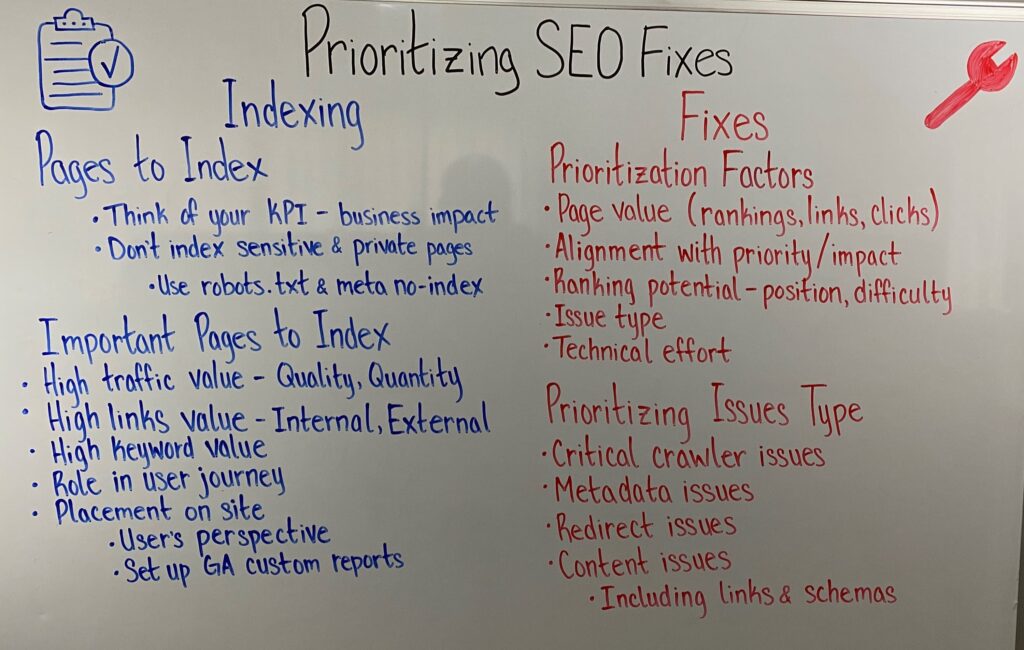Technical SEO is the process of optimizing your website for the search engines. It includes optimizing your website’s code, structure, and content for the search engines. Technical SEO also involves improving your website’s speed and performance.
Technical SEO is the practice of optimizing a website for Google’s search algorithm. It’s a subset of SEO that focuses on improving a website’s architecture, code, and structure to make it easier for Google to crawl and index the site. Technical SEO can be time-consuming and complex, but it’s an important part of any SEO strategy.
Here are some common technical SEO tasks:
1. Optimize your website’s structure and hierarchy.
2. Improve your website’s load time and page speed.
3. Fix broken links and 404 errors.
4. Improve your website’s mobile usability.
5. Increase your website’s security with HTTPS encryption.
What is Technical SEO and Why is it Important? – 4.1. SEO Course by Ahrefs
What Does Technical Seo Stand For?
Technical SEO stands for optimizing your website for the search engines. This includes optimizing your website’s code, structure, and content to make it more visible and accessible to the search engines.
One of the most important aspects of technical SEO is making sure your website’s code is clean and well-organized.
This helps the search engine spiders crawl and index your site more easily, which can lead to better rankings. Another important aspect is ensuring that your site’s content is relevant and keyword-rich. This helps the search engines understand what your site is about and match it with relevant searches.
If you want to improve your website’s visibility in the search engines, paying attention to technical SEO is a must. By following best practices for technical SEO, you can help ensure that your site appears higher in the search results and gets more traffic from potential customers.
What is the Difference between Technical Seo And Seo?
SEO is an acronym for “search engine optimization” or “search engine optimizer.” Deciding to hire an SEO is a big decision that can potentially improve your site and save time, but you can also risk damage to your site and reputation. Make sure to research the potential advantages as well as the damage that an irresponsible SEO can do to your site.
Many SEOs and other agencies and consultants provide useful services for website owners, including:
Review of your site content or structure
Technical advice on website development: for example, hosting, redirects, error pages, use of JavaScript
Content development
Management of online business development campaigns
Identification of keywords and search engines
SEO training
Expertise in specific markets and geographies.
Technical SEO is the process of optimizing a website for Google’s ever-changing algorithm.
It’s a never-ending task because Google makes changes every day (on average).
In general, technical SEO includes optimizing both on-page and off-page factors like:
Site speed
Mobile responsiveness
Indexation
Crawlability
Security (SSL/HTTPS)
What are Technical Seo Skills?
Technical SEO is the process of optimizing a website for the search engines. It involves improving the site’s architecture, code, and content so that the search engines can easily crawl and index the site. Technical SEO also includes optimizing the site’s metadata and creating sitemaps.
Improving a website’s architecture means making sure that the site’s structure is easy for the search engines to understand. This includes ensuring that all of the pages are reachable from one another and that there are no broken links. The code on each page should also be clean and well-organized.
The content on a website must be keyword-rich and relevant to what users are searching for. In addition, all of the pages on a site should have unique titles and descriptions to help the search engines understand what each page is about. Creating sitemaps helps the search engines find all of the pages on a site so that they can be indexed properly.
What is Technical Seo And On-Page Seo?
Technical SEO is the process of optimizing a website for the purpose of improving its ranking in search engine results pages (SERPs). The main aim of technical SEO is to improve the visibility and discoverability of a website in order to increase its traffic and ultimately, its revenue.
There are many factors that contribute to technical SEO, such as site structure, URL structure, sitemaps, metatags, keyword research, content optimization, link building, and more.
While some of these factors may be outside of your control (such as site structure), there are many things you can do to optimize your website for better search engine visibility.
On-page SEO is the process of optimizing individual web pages in order to rank higher and earn more relevant traffic in search engines. It’s about making sure your pages have the right keyword density , titles , meta descriptions , images , etc.
When done correctly, on-page SEO can give you a big boost in search rankings .
Off-page SEO refers to all of the activities that you can do outside of your website to rank higher and earn more relevant traffic in search engines. This includes things like link building , social media marketing , directory submission , etc.

Credit: www.techwyse.com
Technical Seo Checklist
No matter how good your website is, it won’t draw in traffic and convert leads if it isn’t optimised for search engines. This is where technical SEO comes in.
Technical SEO is the process of making sure your website is structured in a way that makes it easy for search engines to find, index, and understand your content.
It’s an important part of any holistic SEO strategy, and should be given attention early on in the process.
To help you make sure your website is technically sound, we’ve put together this comprehensive technical SEO checklist. Use it as a guide when auditing or building websites, and you’ll be well on your way to better search engine visibility.
1. Check Your Site’s Indexation Status
The first step in any technical SEO audit is to check whether or not your site is being indexed by search engines. You can do this using Google Search Console (formerly known as Google Webmaster Tools).
If your site isn’t being indexed, there’s no point in continuing with the audit until you fix the issue. Only once you’re confident that all of your pages are being indexed should you move on to step 2.
2. Analyse Your Site’s Crawlability
Once you know that all of your pages are being indexed, it’s time to take a look at how easily search engine crawlers can access and understand them. The best way to do this is using Screaming Frog’s free SEO Spider tool .
Run a crawl of your entire website using the tool, and then switch over to the ‘Response Codes’ tab to see which pages are returning errors (4xx status codes) or server issues (5xx status codes).
Any pages that fall into either of these categories will need to be fixed before moving on.
While you’re analysing crawlability, also take a look at the ‘Meta Data’ tab to check for any duplicate titles or descriptions – these can cause problems with search engine indexation too . If you spot any duplicates, make sure they’re fixed before continuing with the audit .
3. Review Your Page Titles & Meta Descriptions Once you’ve taken care of indexation and crawlability issues , it’s time to start optimising individual web pages for target keywords . A good place to start is with page titles and meta descriptions , as these are often used by search engines as snippets in SERPs .
Types of Technical Seo
There are many different types of technical SEO, and each one is important in its own way. Here are some of the most common types:
1. Title Tags
Title tags are one of the most important aspects of technical SEO. They tell search engines what your page is about, and they appear in the search results. Make sure to include keywords in your title tags so that you can rank for those keywords.
2. Meta Tags
Meta tags are another important aspect of technical SEO. They provide information about your page to search engines, and they can help you rank for certain keywords.
Be sure to include relevant keywords in your meta tags so that you can improve your chances of ranking well.
3. XML Sitemaps
XML sitemaps help search engines find all the pages on your website so that they can be indexed properly.
If you have a large website, it’s especially important to submit an XML sitemap to Google so that all your pages will be found and indexed correctly. You can use a tool like XML-SitemapsGenerator to generate an XML sitemap for your website automatically. Just enter your website URL and click “Generate Sitemap” – it’s that easy!
4 . robotsTxt file
RobotsTxt is a text file that tells search engine crawlers which pages on your website they should index and which ones they should ignore .
You can use the robotsTxt file to prevent certain pages from being indexed , such as duplicate content or thin content . You can also use it to tell crawlers how often they should crawl specific pages on your site . 5 . 301 Redirects When you change the URL of a page on your site , you need to set up a 301 redirect . This tells search engines that the old page has been permanently moved to the new URL , and it ensures that any link juice (ranking power) from the old page gets transferred to the new page . 6 . 404 Error Pages A 404 error occurs when someone tries to access a non-existent page on your website . It’s important to set up custom 404 error pages so that people don’t get frustrated and leave your site if they happen to stumble across a broken link .
Technical Seo Vs On-Page Seo
Technical SEO and on-page SEO are both important for optimizing your website, but they serve different purposes. Technical SEO focuses on improving the backend of your site to make it more search engine friendly, while on-page SEO focuses on optimizing the content and design of your site to improve your ranking in search results.
Technical SEO includes things like improving your site’s speed and performance, making sure your URLs are formatted correctly, and fixing any broken links.
On-page SEO, on the other hand, is all about creating high-quality content that is relevant to your target keywords and using those keywords throughout your site in a way that is both natural and effective.
Both technical SEO and on-page SEO are important for getting your website ranked higher in search results. However, you may want to focus more on one or the other depending on where you’re starting from.
If your site is already fairly well optimized from a technical standpoint, then you may want to focus more on creating great content. Alternatively, if you have great content but need to work on some technical aspects of your site, then that should be your priority.
Conclusion
Technical SEO is the process of optimizing a website for the search engines. It involves improving the site’s architecture, code, and content so that the search engines can index and rank it correctly. Technical SEO is a complex and ever-changing field, but it’s important for any website that wants to be visible in the search results.



